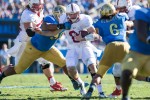On Thursday, No. 18 UCLA (4-1, 1-1 Pac-12) faces a team that has been a perennial thorn in the Bruins’ side: Stanford (4-1, 3-0). The No. 15 Cardinal are riding a seven-game win streak against the Bruins that dates back to 2009. As of Tuesday night, Stanford is listed as a 6.5-point favorite at home.
Here’s a scouting report for a pro-style, physical Stanford team, led by fifth-year coach David Shaw and redshirt senior quarterback Kevin Hogan.
Stanford’s offense
Base formation: I-formation
Run/pass ratio: 63 percent run, 37 percent pass
Blocking style: Man
Strength: Efficiency on standard downs
Weakness: Efficiency on passing downs
X-factor: QB Kevin Hogan
Anyone who watched the UCLA-Stanford game last year knows that the scouting report against Kevin Hogan didn’t matter, because he was just too good to be stopped. The Stanford quarterback finished that game with only three incompletions, dicing up UCLA on multiple play-action passes downfield.
“They don’t hide anything. … I mean, there’s nothing really to trick you,” said UCLA junior weakside linebacker Deon Hollins. “They’re gonna line up, run the ball on first and second down (and) try to get in manageable situations.”
That’s exactly what the Cardinal did against the Bruins last year: gain solid yardage on first and second down to set up third-down and short situations. When they did that, it left offensive coordinator Mike Bloomgren’s playbook wide open on third down – he could pass, he could run or he could play-action pass.
That theme has continued into this year for Stanford. The Cardinal rank No. 7 in the nation in standard-down offensive efficiency, meaning they are very effective in maintaining and converting reasonable down-and-distance setups. Overall, Stanford is No. 4 in the nation with an offensive success rate of 133.7.
However, when the Cardinal aren’t able to get into those third-down and manageable situations, their offense loses potency. While Stanford is No. 7 in standard-down efficiency, it is just No. 59 in passing down efficiency. A key for the UCLA defense will be to stop the run on the early downs to force Stanford into obvious passing situations on third down. If the Bruins do that, Bloomgren’s play calling won’t be as deceptive and the play-action pass won’t be as lethal of a weapon for Hogan.
Stanford’s defense
Base defense: 3-4
Blitz tendency: Light to moderate
Strength: Discipline, strong tackling
Weakness: Lack of depth on defensive line
X-factor: ILB Blake Martinez
Thursday’s game will present UCLA’s best chance to run the ball against Stanford in years.
The Cardinal’s defensive line is short on depth and lacks any All-Pac-12 candidates. Their best defensive lineman – defensive end Harrison Phillips – is out for the year with a torn ACL, and their linebackers unit is good but not great.
Overall, the Stanford defense should be a lighter test for UCLA than the Arizona State defense was on Oct. 3. ASU ranks No. 24 in run defense, allowing 3.32 yards per carry, whereas Stanford ranks No. 39, allowing 3.58 yards per carry.
There are two things that the Cardinal still do really well defensively: scheming and tackling. Lance Anderson is in his second full season as Stanford’s defensive coordinator and, despite some personnel setbacks this year, he has mitigated large losses on the stat sheet, as Stanford ranks No. 28 in scoring defense and total defense.
The key for UCLA’s offense against Stanford’s defense will be the tactical matchup between Anderson and UCLA offensive coordinator Noel Mazzone. For the first time in years, the Bruins’ offense has the talent edge over the Cardinal defense, but it will be up to Mazzone to take advantage of it. If Mazzone’s play calling is versatile early on, the Bruins could gain some much-needed momentum out of the gates. But if Mazzone continues to be predictable with his first-down play calling in the first half, then UCLA will probably get off to a rough start and never be able to overcome it.
Compiled by Matthew Joye, Bruin Sports senior staff.
